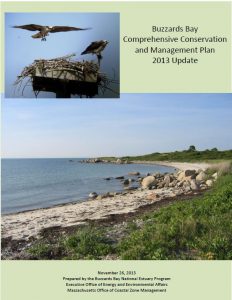2013 CCMP, Action Plan 3:
Managing Stormwater Runoff and Promoting LID
About the new Buzzards Bay CCMP Action Plans
The Buzzards Bay Comprehensive Conservation and Management Plan (CCMP) was updated in November 2013 to reflect the great progress achieved since the original CCMP was finalized. We want your feedback on this action plan. First, read the complete Stormwater management and LID action plan (a 508 kb pdf file).
At the bottom of this page is a link for you to provide comments on each goal, objective and defined management approach contained in this Action Plan. Based on your feedback, we will update and revise all the action plans in the new CCMP.
Managing Stormwater Runoff and Promoting LID
Problem
Thousands of stormwater pipes and overland flows discharge contaminated runoff into Buzzards Bay and its tributaries. Connected to these pipes are tens of thousands of catch basins and hundreds of miles of pipes that convey numerous allowed and illicit pollution discharg-es. New development adds stormwater to this discharge network. These stormwater discharges pose many threats to the environment, not the least of which is the closure of shellfish beds and swimming beaches in Buzzards Bay. Federal permit programs that may require compli-ance with daily load limits for bacteria, and other requirements for municipal stormwater programs, could cost more than a $1 billion in the coming decades. These efforts, while costly and politically challenging, will dramatically reduce shellfish bed closures in Buzzards Bay and restore habitat in many areas to conditions not seen for decades.
The ongoing development and redevelopment of land in the Buzzards Bay watershed must be better managed and reprogrammed to minimize new impacts and mitigate existing problems caused by stormwater discharges. This new approach, called low impact development (LID), can restore hydrological balances in watersheds and reduce water quality impairments.
Goals
Goal 3.1. Prevent new or increased untreated stormwater flows to Buzzards Bay and contributing watershed areas that would adversely affect shellfishing areas, swimming beaches, water quality, and wetlands.
Goal 3.2. Correct existing stormwater runoff flows to Buzzards Bay and contributing watershed areas that are adversely affecting shellfishing areas, swimming beaches, water quality, and wetlands, or exceeding watershed total pollutant load limits.
Goal 3.3. Maintain and restore natural hydrologic conditions to provide base flow conditions to streams, wetlands, and estuaries.
Goal 3.4. To encourage low impact development (LID) techniques in new development and redevelopment, in order to minimize impacts from stormwater.
Objectives
Objective 3.1. To adopt and implement local and state stormwater LID laws and regulations.
Objective 3.2. To implement effective stormwater pollution remediation projects that include proper design, construction, operation, and maintenance.
Objective 3.3. To provide guidance and incentives for LID that reduces and re-uses stormwater runoff, and reduces the need for structural practices.
Objective 3.4. To improve compliance with federal, state, and local stormwater regulations and meet watershed total pollutant load limits.
Approaches
LID approaches are best implemented through local bylaws and ordinances that regulate subdivisions, and commercial development, through new municipal stormwater permit programs, and will require additional training of regulatory and technical assistance staff.
The elimination of water quality impairments caused by existing stormwater discharges is a major undertaking that will require actions and expenditures by all levels of government. EPA must enforce compliance with the Buzzards Bay pathogen TMDL through MS4 stormwater permits. DEP must upgrade state stormwater policy to include treatment standards for nitrogen and bacteria, and EEA must promote policies and regulations that foster low impact development techniques. The largest burden rests with municipalities, which will need to develop and implement meaningful stormwater management programs for themselves and the private sector supported by sound local laws, regulations, and policies.
Costs and Financing
LID approaches have modest costs for government to implement, and some approaches can even reduce development and long-term maintenance costs borne by residents. The most daunting costs will be to treat existing discharges causing degradation and to implement municipal stormwater programs that support these goals. This effort will likely cost more than $1 billion over several decades. The costs will likely be met through federal and state SRF loan programs, or through local financing like stormwater utilities.
Measuring Success
LID and stormwater goals will be tracked principally by programmatic actions such as the adoption of necessary laws and regulations. More importantly, documenting compliance with EPA stormwater permits and stormwater TMDLs including constructing stormwater treatment systems, or eliminating stormwater discharges, and implementing good housekeeping programs will be key measures. A key measure of success will be im-provements to water quality, as evidenced by reductions in the extent or duration of shellfish closures.
